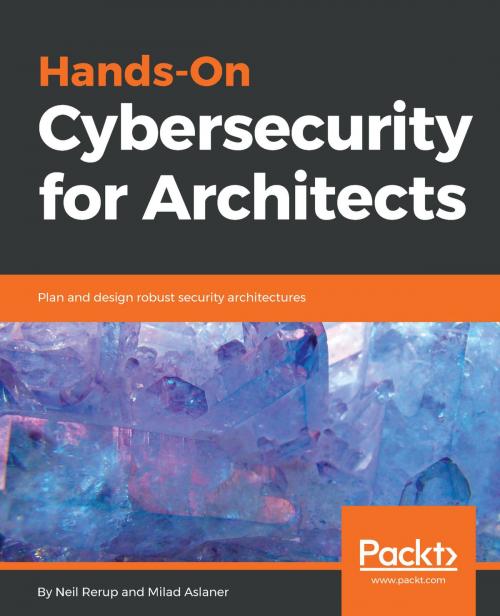Hands-On Cybersecurity for Architects
Plan and design robust security architectures
Nonfiction, Computers, Networking & Communications, Computer Security, Operating Systems, Application Software| Author: | Neil Rerup, Milad Aslaner | ISBN: | 9781788627238 |
| Publisher: | Packt Publishing | Publication: | July 30, 2018 |
| Imprint: | Packt Publishing | Language: | English |
| Author: | Neil Rerup, Milad Aslaner |
| ISBN: | 9781788627238 |
| Publisher: | Packt Publishing |
| Publication: | July 30, 2018 |
| Imprint: | Packt Publishing |
| Language: | English |
Gain practical experience of creating security solutions and designing secure, highly available, and dynamic infrastructure for your organization
Key Features
- Architect complex security structures using standard practices and use cases
- Integrate security with any architecture solution
- Implement cybersecurity architecture in various enterprises
Book Description
Solutions in the IT domain have been undergoing massive changes. There was a time when bringing your own devices to work was like committing a crime. However, with an evolving IT industry comes emerging security approaches.
Hands-On Cybersecurity for Architects will help you to successfully design, integrate, and implement complex security structures in any solution whilst ensuring that the solution functions as expected. To start with, you will get to grips with the fundamentals of recent cybersecurity practices, followed by acquiring and understanding your organization's requirements. You will then move on to learning how to plan and design robust security architectures, along with practical approaches to performing various security assessments. Once you have grasped all this, you will learn to design and develop key requirements, such as firewalls, virtual private networks (VPNs), wide area networks (WANs), and digital certifications. In addition to this, you will discover how to integrate upcoming security changes on Bring your own device (BYOD), cloud platforms, and the Internet of Things (IoT), among others. Finally, you will explore how to design frequent updates and upgrades for your systems as per your enterprise's needs.
By the end of this book, you will be able to architect solutions with robust security components for your infrastructure.
What you will learn
- Understand different security architecture layers and their integration with all solutions
- Study SWOT analysis and dig into your organization’s requirements to drive the strategy
- Design and implement a secure email service approach
- Monitor the age and capacity of security tools and architecture
- Explore growth projections and architecture strategy
- Identify trends, as well as what a security architect should take into consideration
Who this book is for
Hands-On Cybersecurity for Architects is for you if you are a security, network, or system administrator interested in taking on more complex responsibilities such as designing and implementing complex security structures. Basic understanding of network and computer security implementation will be helpful. This book is also ideal for non-security architects who want to understand how to integrate security into their solutions.
Gain practical experience of creating security solutions and designing secure, highly available, and dynamic infrastructure for your organization
Key Features
- Architect complex security structures using standard practices and use cases
- Integrate security with any architecture solution
- Implement cybersecurity architecture in various enterprises
Book Description
Solutions in the IT domain have been undergoing massive changes. There was a time when bringing your own devices to work was like committing a crime. However, with an evolving IT industry comes emerging security approaches.
Hands-On Cybersecurity for Architects will help you to successfully design, integrate, and implement complex security structures in any solution whilst ensuring that the solution functions as expected. To start with, you will get to grips with the fundamentals of recent cybersecurity practices, followed by acquiring and understanding your organization's requirements. You will then move on to learning how to plan and design robust security architectures, along with practical approaches to performing various security assessments. Once you have grasped all this, you will learn to design and develop key requirements, such as firewalls, virtual private networks (VPNs), wide area networks (WANs), and digital certifications. In addition to this, you will discover how to integrate upcoming security changes on Bring your own device (BYOD), cloud platforms, and the Internet of Things (IoT), among others. Finally, you will explore how to design frequent updates and upgrades for your systems as per your enterprise's needs.
By the end of this book, you will be able to architect solutions with robust security components for your infrastructure.
What you will learn
- Understand different security architecture layers and their integration with all solutions
- Study SWOT analysis and dig into your organization’s requirements to drive the strategy
- Design and implement a secure email service approach
- Monitor the age and capacity of security tools and architecture
- Explore growth projections and architecture strategy
- Identify trends, as well as what a security architect should take into consideration
Who this book is for
Hands-On Cybersecurity for Architects is for you if you are a security, network, or system administrator interested in taking on more complex responsibilities such as designing and implementing complex security structures. Basic understanding of network and computer security implementation will be helpful. This book is also ideal for non-security architects who want to understand how to integrate security into their solutions.















